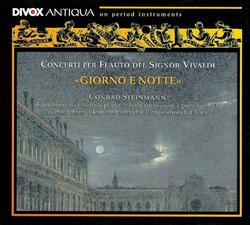| All Artists: Conrad Steinmann;Ensemble 415 Title: Giorno e Notte Members Wishing: 0 Total Copies: 0 Label: Divox Original Release Date: 1/1/2010 Re-Release Date: 7/1/2002 Album Type: Single Genre: Classical Styles: Chamber Music, Historical Periods, Classical (c.1770-1830) Number of Discs: 1 SwapaCD Credits: 1 UPC: 7619913700063 |
Search - Conrad Steinmann;Ensemble 415 :: Giorno e Notte
 | Conrad Steinmann;Ensemble 415 Giorno e Notte Genre: Classical
Performing artist Conrad Steinmann has devoted a great deal of time and energy to a question that may seem quite banal: 'What kind of flute was Vivaldi's in reality?' And in his search for answers, he came across Bartolo-m... more » |
Larger Image |
CD Details
Synopsis
Product Description
Performing artist Conrad Steinmann has devoted a great deal of time and energy to a question that may seem quite banal: 'What kind of flute was Vivaldi's in reality?' And in his search for answers, he came across Bartolo-meo Bismantova. This scholar's manuscript treatise 'Compendio Musicale' of 1677 contains detailed instructions for the performance of various instruments. Following a general introduction to music theory comes a remarkably extensive treatment of the recorder. It describes the 'flauto italiano' as an instrument in three sections bored and turned in the Baroque fashion, and with the ground note g' (he also mentions a different-sized instrument with the ground note d'). Thanks to this knowledge and the ensemble's extraordinarily spirited music-making, Vivaldi's works can now be heard with a new freshness. No fewer than six differently bored and tuned instruments were used, and they cast a surprising new light on Vivaldi's world of sounds. This discovery of 'new' tone colors and the logic of unexpected new fingering techniques lend a unique brilliance to this recording and provide a compelling and infectiously invigorating listening experience. Instruments: recorder in d' made by Frederick G. Morgan (Track no. 1-3) | recorder in e flat' made by Frederick G. Morgan (Track no. 15-20) | recorder in g' made by Ernst Meyer (Track 4-5, 12-14) | recorder in c'' made by Ernst Meyer (Track 8,10) | recorder in c'' made by Frederick G. Morgan (Track 9) | First Violin: Nicola Amati, Cremona 1684 | Second Violin: Sebastian Klotz, 1750 | Viola: Andrew Fairfax, 1979 | Violoncello: Norman Barak, London 1710 | Double bass: Anonymous, France 18th century | Lute: Richard Earle, Basle 1986 | Harpsichord: Gianfranco Facchini, Lugo di Romagna 2001

 Track Listings (20) - Disc #1
Track Listings (20) - Disc #1